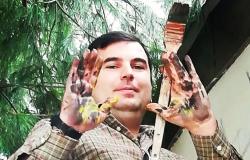To understand Jacopo Merizzi and the spirit with which he wrote Life in the eyes (pp. 206, 22 euros, CAI Editions 2024)just scroll through numerous photographs presentin color in the insert, in black and white between the pages: wonderful shots that tell amazing stories adventures around the world, from Antarctica to Chiapas, from Albania to Yosemite Valley, from Jordan to Wanuatulooking for walls to climb or to pack photo reports commissioned by important magazines. There is no shortage of places of the heart, first of all there Val di Mellothe kingdom of Italian big walls and grip climbing, where with Sassisti – of which he is one of the prominent members and founders – has opened over 40 routes with iconic names, such as Patabang in 1979 (director Andrea Frigerio recounts that world in the film of the same name present in the CAI Cineteca catalogue), later the subject of several guides. Many group snapshots, numerous faces of dear adventure companions (and the term here truly takes on its truest meaning). There are even some of the clients he has been accompanying since, at the age of 18 (“and a month”, he specifies), he became mountain guide.
Incredibly, it is the author’s face that almost never appears: and in an autobiography it is very indicative. Merizzi is the narrator, the photographer, the point of view of his book, not the egocentric protagonist of an existence in search of compliments. He shows himself in a few cheeky and amused shots, even the cover photo is the result of long research. A light-hearted and friendly, slightly crazy look dominates everythingas he suggests Andrea Gobetti in the introduction that embellishes this one new expanded edition of the book, adding to the preface of Marco Albino Ferrari. Reading the book is a pleasant moment, at times truly hilarious. To get an idea by listening directly to the authoryou can participate in the presentation scheduled for Saturday 27 April at 10.30 am at the Trento Film Festival, in the Montagnalibri Literary Lounge, in Piazza Duomo.
Jacopo Merizzi, the book opens by telling you about that time you almost died, at 50 years old. You do it your way, almost as if it were no big deal, yet the accident was very serious. How much did that episode impact you?
In the book I tell episodes of my life that seem almost impossible… I use the images to demonstrate that they actually happened, to contrast a bit of realism with my light and surreal gaze. If I have to talk seriously about myself, I actually experienced a dramatic moment and deciding to come back to life was a very difficult choice. I had suffered 57 fractures, three hemorrhages, I was really as good as dead, and since I had already suffered them all, I asked myself if it was worth returning from the afterlife. When I saw that I could still move in the mountains I said to myself: yes, it’s still worth it. The tragedy is that I haven’t changed at all though! I’m as distracted as before, still happy, still entertained by life, just a little less shrewd, so sometimes I have to be more careful.
You will have changed a little!
I’ll tell you an anecdote that I didn’t put in the book: after such a major trauma, after months of operations, I was still moving around in a wheelchair, which was very painful for me. They advised me to go to the neuropsychiatrist, so I prepared myself as best I could to pass the “exam”. I sit in front of the doctor and she asks me what year it is. I answer you nineteen hundred… (the accident occurred in 2010, Ed.). She asks me the season. I look outside, trying to understand if it is spring or summer… I “fail”. I then return with my wife Michela, she asks me the same questions again and I repeat the same scene. “Look, it was like this before,” says Michela… And with this she saved me. Well, I haven’t changed.
Of your numerous explorations, which one has remained in your heart? Notwithstanding that in Antarctica we see you vomiting on the deck of the Pelagic, or returning from Chiapas with severe pneumonia…
One of the most beautiful places I visited was southern Algeria, where the desert has extraordinary variety. I had to go to Antarctica for a photo shoot for an important brand, but when I left I had no more equipment, because my first wife had thrown it at me while I was running away from home in my underwear… She gave me the money to get to Ushuaia I lent the director Marco Preti, one of my colleagues at Pelagic, and so I managed to buy a second-hand camera and another lens, which together with the one my wife had thrown at me was enough for me. We spent three months on this small 14 meter boat, it was difficult for me to share such narrow spaces.
But have you really met the ghost of the two Italian researchers from the 1930s who died in Antarctica?
I’ll tell you. I had camped alone, because I could no longer stand the company of others and traveling across these immense expanses of ice and that’s it. At night I hear a terrifying scream, “let me in” she said, in Italian! But there was no one outside the tent! I felt enormous fear and I couldn’t sleep anymore. Discovering that Marco Preti, kilometers away, had also had the same experience struck me a lot. Antarctica is very photogenic, there are incredible contrasts of green, blue, red sunsets, because the sun always remains on the horizon, the temperatures are not so cold, always around zero. But the most beautiful thing about Antarctica is not when you go, sailing against the wind on the stormy sea of the Drake Strait, but when you return: seeing Cape Horn and smelling the vegetation again after months of only ice is fantastic! You realize how beautiful our world is.
You’ve had environmental battles, but this is an awareness that you seem to have developed over time.
When I started the world was big, going to America by plane was an exception. I opened dozens of rock and ice routes because there was so much to do. For a young person today it is very different: almost everything has been done, the world has become small. And then it’s also true that when I was 20 I didn’t have many problems… But then you realize that you have to pay a lot of attention to the environment. We must not leave traces, we must enter on tiptoe and this is the most beautiful and most modern thing we can do. In Val di Mello it took us a while to understand the message, then it entered our hearts. In Antarctica I confess that I was moved when I found the waste left by researchers 70 years earlier, but here, where the environment is totally anthropized, it is the opposite: we need to find wild places, unmarked routes, unstuck walls.
Melloblocco will be held soon, will you participate?
I always go there, because it’s not a competition, but a party where everyone comes together to climb, each at their own level. But above all it is a gathering of young people, and I am moved to see the young people, with their joy, their freedom.
In Val di Mello you have led several environmental battles, and you are considered one of its greatest defenders.
Val di Mello is an almost unique case. It was the Vajont that saved it, because when the project to build a dam in Predarossa was underway in the 1960s, the tragedy occurred in Erto and Casso, and then Enel backed out, considering that perhaps the area was not was geologically ideal, because there is the point of contact between the granites of Val Masino and the serpentines of Valmalenco. I won’t go over all the subsequent events, the important thing is that today what saved Val di Mello was a movement born from below.
It is precisely the beauty of Val di Mello that has caused its overcrowding. How is the problem solved?
I know, also because it is close to Milan… They can limit access to Yosemite, because it is state property, whereas the road that goes up to Val di Mello is divided into many private owners. Here they thought about charging for parking, but that’s not enough. I don’t know how to solve the problem. It is also true, however, that the valley floor is very popular and is easy to access. All you have to do is climb for a quarter of an hour to find wild and desolate places. Wonderful walls a thousand meters high, worked by ice, smooth and rounded, geological anomalies, surrounded by waterfalls… It is exceptional beauty.
You have an attempted degree in natural sciences behind you, but in the book we discover your passion for archaeology. In Marettimo, in the Egadi Islands, you also made important discoveries.
I didn’t get my degree because I was always traveling around the world… I always go back to Marettimo, it’s an island that has entered my heart, and I’ve visited all the islands, in Greece, in Libya, in Turkey … Archeology fascinates me because I am curious. I am attracted by the idea of entering a cave almost 2000 years after the last man engraved rock inscriptions there and finding mummies or objects left there. You feel like an intruder and you understand even more how important it is to tiptoe in. The brush phase, however, bores me and I leave the field to the archaeologists. The discoveries made in Marettimo served to push back the use of boats in the Mediterranean by two thousand years and were also published in prestigious magazines, «Earth-Science Reviews” And “National Geographic».
One of the chapters is dedicated to your customers. Have they changed over time? How do you choose them?
The client forms the guide, but he is nothing more than a companion looking for someone with more experience to live an adventure with. Then it always depends on the clients you bring, if they are children, or if they are already strong, it is a varied profession. I have always chosen a few, who have often become friends. Customers are like lovers, they are not chosen or rejected, at most they are avoided. They haven’t changed in 50 years: it means they’re all alive again.
Are you still a stoner?
Maybe yes, stripped, aged, but yes. It was a beautiful moment of youth, of energy. I have always loved breaking the mold, for me climbing is absolute freedom. The Sassisti were reckless young people who found nature the only place to cultivate their passion. Even if the young man I was would avoid me today, as I avoided all the old people, and would do the opposite of what I say, because I have always been a contrary bastian.
Do your children do this?
My son is a very good engineer who still thinks he can change me, he tells me that maybe it’s time to do something… But at 65, doing nothing is an acquired right! My older daughter looks at me like older people look at each other, with tenderness.
Tags: Scarpone book week Life eyes Interview Jacopo Merizzi







